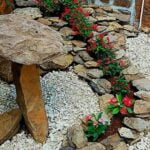Looking for innovative gardening ideas with cinder blocks? Cinder blocks are versatile, affordable, and durable materials that have been gaining popularity in the world of gardening. From raised beds to planters and seating, cinder blocks offer endless possibilities for garden design and landscaping. In this article, we will explore the history and benefits of using cinder blocks in gardening, as well as provide tips and creative ideas for incorporating them into your outdoor space.
Cinder blocks, also known as concrete masonry units (CMUs), are commonly used in construction due to their strength and stability. However, they have also become a popular choice for DIY garden projects. Their affordability, ease of use, and ability to withstand outdoor conditions make them an excellent option for creating functional and visually appealing garden structures.
Throughout the years, gardeners have discovered the numerous benefits of using cinder blocks in their outdoor spaces. Not only are they durable and long-lasting, but they also provide a versatile canvas for creativity in garden design.
From traditional to modern styles, cinder blocks have proven to be a valuable asset in constructing raised beds, planters, seating areas, and more. Whether you are a seasoned gardener or just starting out, there are countless ways to integrate cinder blocks into your garden.
Choosing the Right Cinder Blocks for Your Garden
When it comes to choosing the right cinder blocks for your garden, there are a few factors to consider in order to ensure the success of your gardening project. Cinder blocks come in different sizes, shapes, and strengths, so it’s important to select the best ones for your specific gardening needs.
When selecting cinder blocks for your garden, consider the following:
- Types of cinder blocks available: There are different types of cinder blocks, including solid blocks, hollow blocks, and decorative blocks. Each type has its own advantages and uses in gardening projects.
- Size and shape: Determine the size and shape of the cinder blocks that will work best for your garden design. Some projects may require standard rectangular cinder blocks, while others may benefit from specialty shapes or sizes.
- Strength and durability: Look for high-quality cinder blocks that are durable and can withstand the elements. This is especially important for outdoor gardening projects where the blocks will be exposed to weather conditions.
In addition to these considerations, finding affordable cinder blocks for your project is also crucial. Whether purchasing new or used cinder blocks, here are some tips for getting them at a reasonable cost:
- Check local hardware stores or construction supply companies for bulk discounts on cinder blocks.
- Search online marketplaces or classified ads for used cinder block listings in your area.
- Consider alternative materials such as concrete bricks or pavers as budget-friendly alternatives to traditional cinder blocks.
By carefully selecting the right type of cinder block and finding affordable options, you can set yourself up for success in creating a beautiful and functional garden with this versatile building material. Whether you’re building raised beds, planters, retaining walls, or other structures, choosing the right cinder blocks is an essential step in any gardening project.
Designing Your Garden With Cinder Blocks
When it comes to incorporating gardening ideas with cinder blocks, the possibilities are truly endless. One creative way to use cinder blocks in garden design is by building raised bed gardens. These structures provide a defined space for planting, help prevent soil compaction, and can even make gardening more accessible for individuals with physical limitations. Additionally, cinder blocks can be used to create planters in various shapes and sizes, allowing for a customizable and unique garden design.
Another innovative way to incorporate cinder blocks into your garden is by using them for seating. By stacking cinder blocks in a strategic manner, you can create benches and seating areas that blend seamlessly with your garden’s aesthetic. Whether you prefer a modern or rustic style, cinder blocks offer versatility that allows you to tailor the design to your specific preferences.
For those looking to add a touch of elegance and sophistication to their outdoor space, creating decorative walls and dividers using cinder blocks is an excellent option. By utilizing different patterns and arrangements of the blocks, you can add visual interest and structure to your garden while also effectively delineating different areas within the space.
Ultimately, when it comes to designing your garden with cinder blocks, the key is to let your creativity shine. With these versatile building materials, you have the opportunity to transform your outdoor space into a beautiful and functional oasis that reflects your personal style and gardening aspirations.
| Garden Feature | Description |
|---|---|
| Raised Bed Gardens | Provide defined spaces for planting and prevent soil compaction |
| Seating Areas | Create benches and seating areas that blend seamlessly with the garden’s aesthetic |
| Decorative Walls and Dividers | Add visual interest and structure while delineating different areas within the space |
Planting and Maintaining a Cinder Block Garden
Cinder blocks are a versatile and affordable option for creating garden structures such as raised beds, planters, and seating. When selecting cinder blocks for your garden, it’s important to consider the type of block that will best suit your needs.
Standard cinder blocks are the most common choice, but there are also specialty blocks available, such as those with cut-outs for planting pockets or with built-in seating areas. Consider the size and weight of the blocks, as well as any additional features you may need for your specific gardening project.
Once you have chosen the right cinder blocks for your garden, it’s time to start planning your planting and maintenance strategy. One popular method is filling each block with soil and planting directly into them. This works best for smaller plants or herbs, but be mindful of proper spacing and drainage to ensure healthy growth. Another option is to use the cinder blocks to create raised beds, providing a deeper soil depth for larger plants and vegetables.
When maintaining a cinder block garden, it’s important to stay vigilant about watering and drainage. While cinder blocks can provide excellent structure and support for plants, they can also retain water if not properly maintained. To prevent issues such as root rot or mold growth, be sure to monitor water levels within your block structures and make adjustments as needed.
In addition to watering considerations, it’s also essential to prevent common gardening issues when using cinder blocks. Over time, exposure to weather elements can cause wear on the blocks, leading to potential structural issues. Properly sealing or treating the blocks can help protect them from damage caused by moisture or temperature changes.
Regular maintenance tasks such as cleaning debris or inspecting for cracks will also contribute to keeping your cinder block garden in tip-top shape. By following these practices for planting and maintaining a cinder block garden, you can ensure the health and longevity of your plants while enjoying the structural benefits of this versatile material.
DIY Projects With Cinder Blocks
Cinder blocks are incredibly versatile and can be used to create a wide range of DIY projects for your garden. Whether you’re a seasoned gardener or just starting out, there are plenty of creative gardening ideas with cinder blocks that you can easily tackle. From simple planters to more complex raised bed gardens, the possibilities are endless.
One popular DIY project using cinder blocks is creating a vertical garden. By stacking the blocks in different configurations, you can design a unique and space-saving way to grow herbs, flowers, or even vegetables. The nooks and crannies of the cinder blocks provide ideal spaces for planting, making it an efficient and visually appealing way to maximize your garden space.
Another fun and practical gardening idea with cinder blocks is building a bench or seating area. By arranging the blocks in a sturdy formation, you can fashion durable outdoor furniture that perfectly complements your garden design. Add colorful cushions and throws to create a cozy and inviting outdoor space where you can relax and enjoy your garden.
For those looking for a bigger project, consider constructing a cinder block raised bed garden. This type of structure not only adds depth and dimension to your garden but also makes it easier to tend to your plants without having to bend over. Plus, cinder block raised beds are long-lasting and require minimal maintenance, making them an excellent investment for any gardener.
| Gardening Idea | Description |
|---|---|
| Vertical Garden | Create a space-saving way to grow herbs, flowers, or vegetables using stacked cinder blocks. |
| Cinder Block Bench/Seating Area | Fashion durable outdoor furniture by arranging cinder blocks into a sturdy formation. |
| Raised Bed Garden | Add depth and dimension to your garden while making it easier to tend plants without bending over. |
Enhancing Your Cinder Block Garden With Accessories
Ideas for Decorating and Enhancing Cinder Block Gardens
When it comes to enhancing your cinder block garden, the possibilities are endless. From adding decorative elements such as wind chimes and hanging plants to practical additions like trellises and seating, there are numerous ways to elevate the aesthetic appeal of your garden.
Consider painting or stenciling your cinder blocks for a personalized touch, or incorporating natural elements such as driftwood or rocks for a rustic look. Additionally, you can create visual interest by arranging different sized blocks in unique patterns or using them as borders for pathways and flower beds.
Tips for Adding Lighting, Seating, and Other Accessories to Your Garden
Lighting is an essential aspect of any garden, especially if you plan on spending time outdoors in the evenings. LED string lights, solar-powered lanterns, and pathway lighting can all be incorporated into your cinder block garden to create a warm and inviting ambiance.
When it comes to seating, consider using cinder blocks to build benches or ledges around the perimeter of raised beds for added functionality. Furthermore, you can add depth and dimension to your garden by installing vertical planters, bird feeders, or even a small water feature.
How to Personalize and Customize Your Cinder Block Garden
Personalization is key when it comes to creating a unique cinder block garden. One way to personalize your space is by adding colorful cushions and throw pillows to seating areas made from cinder blocks. Additionally, you can incorporate decorative planters and containers that reflect your personal style, whether it’s sleek and modern or bohemian chic.
Consider adding artwork or sculptures amidst your greenery for an extra touch of personality. Ultimately, the key is to infuse your space with elements that resonate with you and bring joy to your outdoor oasis.
By choosing the right accessories for your cinder block garden, you can transform a basic gardening project into a personalized haven that reflects your individuality while also enhancing the overall aesthetic appeal of the space. Whether you opt for functional elements like lighting and seating or decorative accents such as art pieces and planters – the possibilities are endless when enhancing your cinder block garden with accessories.
Maintenance and Longevity of Cinder Blocks
When using cinder blocks for gardening projects, it is essential to ensure the longevity and durability of these structures. By taking proper maintenance measures, you can protect your cinder block gardens from wear and ensure that they remain in great condition for years to come.
Protecting Cinder Blocks From Weather and Wear
Cinder blocks are incredibly durable, but they are still susceptible to weather-related damage over time. To protect your cinder blocks from the elements, consider applying a waterproof sealant to keep moisture out and prevent cracking or deterioration. Additionally, painting the cinder blocks with a weather-resistant paint can provide an extra layer of protection against sun exposure and harsh weather conditions.
Maintenance Tasks for Keeping Cinder Block Gardens Looking Great
Regular maintenance is key to ensuring that your cinder block garden remains in top condition. This includes checking for any signs of damage or wear, such as cracks or shifts in the structure. It’s also important to regularly clean the cinder blocks to remove dirt, grime, and debris that can accumulate over time. A simple wash with a mixture of mild soap and water can help keep your cinder block garden looking clean and well-maintained.
Ensuring Longevity of Cinder Block Structures
To ensure the longevity of your cinder block structures in the garden, it’s important to inspect them regularly for any signs of wear or damage. It’s also essential to address any issues promptly by repairing or replacing damaged cinder blocks as needed. By staying on top of maintenance tasks and addressing any issues early on, you can prolong the lifespan of your cinder block gardens and continue to enjoy their benefits for years to come.
Incorporating regular check-ups into your gardening routine will help ensure that your cinder block structures remain strong and sturdy throughout the seasons. With proper care, your cinder block garden will stand the test of time while providing a beautiful backdrop for all your gardening endeavors.
Inspiring Examples of Cinder Block Gardens
In conclusion, gardening with cinder blocks offers a versatile and affordable option for creating beautiful and functional garden spaces. From raised bed gardens to planters and seating, the possibilities are endless when it comes to using cinder blocks in garden design. With the right selection of cinder blocks and some creative ideas, you can easily personalize and customize your garden to suit your style and needs.
When it comes to planting and maintaining a cinder block garden, it’s important to follow best practices for planting in cinder block structures and to ensure proper watering and maintenance of the plants. By taking these steps, you can prevent common gardening issues and keep your cinder block garden looking great all season long.
For those interested in DIY projects, there are countless budget-friendly ideas for using cinder blocks in garden and outdoor spaces. With step-by-step instructions and creative inspiration, even those with limited experience can create stunning additions to their gardens using cinder blocks. Whether it’s a simple planter or a more elaborate seating area, the possibilities for DIY projects with cinder blocks are endless.
In sum, by enhancing your cinder block garden with accessories such as lighting, seating, or decorative elements, you can truly personalize your outdoor space. And by following maintenance tips to protect the longevity of your cinder block structures from weather and wear, you can ensure that your garden remains looking fantastic year after year.
With inspiring examples of successful cinder block gardening projects as showcased throughout this article, readers are sure to feel motivated to create their unique cinder block gardens. Whether modern or rustic in style, there is no limit to the creativity that can be unlocked when exploring gardening ideas with cinder blocks.
Frequently Asked Questions
What Grows Well in Cinder Blocks?
Cinder blocks are versatile and can be used for growing a variety of plants. Vegetables like tomatoes, peppers, and lettuce thrive in cinder block gardens. Herbs, flowers, and even small fruit trees can also be grown successfully in cinder blocks.
Can You Use Cinder Blocks for a Garden?
Yes, you can definitely use cinder blocks for gardening. They make excellent raised garden beds due to their durability and ability to retain heat. With proper soil preparation, drainage, and spacing, cinder blocks provide a sturdy framework for a successful garden.
How Many Cinder Blocks Do I Need for a 4×8 Garden Bed?
To build a 4×8 garden bed using cinder blocks, you will need about 32 cinder blocks if you’re using a typical 8x8x16-inch size block. This will allow you to create a single layer bed that is strong and reliable for your gardening needs.

Welcome to my gardening blog! I am passionate about plants and enjoy sharing my knowledge and experiences with others. In this blog, I will write about everything related to gardening, from tips on how to get started to updates on my own garden projects.





